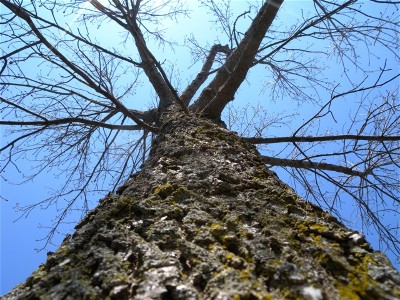Our premier tree of the month is the Illinois State Tree, the White Oak. One of our favorites, although to be honest you will be hearing that a lot from us. We just love trees and so we have a lot of favorites. As you can see from this photo taken just outside New York City, White Oaks in maturity are magnificent and stately beings that deserve the honor we give them. Those dwarfed humans under the boughs of this grandaddy Oak are your arborists, Gilbert and Lesley.
When planning for a White Oak plenty of space requirements are needed as they can reach a branch spread in our area of 40’ to 60’ and reach 80’ tall. They love an acidic well drained soil and do not like getting their roots messed with once they reach adulthood. They start life as a little acorn and maintain a shallow root system that usually is no deeper than 3’ to 6’ with the majority of roots staying in the top 12” of soil...yes, the top 1’ of soil.
Medicinal properties of the Oak are found beneath its bark where a chemical called quercitrin is found that supports the tree’s ability to trap and use sunlight in the shorter wavelengths. It is an important vasoactive drug that helps control human blood pressure. Similar plant compounds were used like Viagra by the pharoahs.
You are on our brand new website! Help us by taking a quick look around and letting us know what you think...suggestions, insights, observations? We would so value your feedback! lesley@thearborsmiths.com
Emerald Ash Borer Update
Backyard Wisdom by Gilbert A Smith
You may have heard that the Illinois Department of Agriculture has released several batches of non native wasps that kill the Emerald Ash Borer. This is good news indicating that the State is on a campaign to slow the borer that has killed over 200,000 Ash trees in Michigan. 
No one knows if this introduction of natural controls will work. Only time will tell. In the mean time we will remain vigilant in protecting our beautiful Ash Trees.
Because it has killed so many trees in Wilmette and Glenview, we are using a stronger, more invasive insecticide called Treeage on select trees. Those of you who have large champion trees or are near infected trees will notice this change of strategy in our annual renewal. The initial application of Treage insecticide is twice as expensive but because this treatment lasts for 2 years the cost increase amortizes to be the same.
Arborsmith is always experimenting and studying what approach is best to keep your trees healthy, while protecting the environment and human health. If you have any questions please feel free to call us, visit our website for more information, or request our Abstract on Emerald Ash Borer.
Confessions of a New Beekeeper
Mother Nature's Moment by Lesley Bruce Smith
 Last year I began a new adventure of keeping bees, or apiculture. I became fascinated after watching a friend work her hives. I was interested in helping the bee populations who are struggling with sudden colony collapse disorder and I hoped to learn more and help with flower pollination in our gardens as well. I got so much more than I bargained for! I am in love with my “girls”.
Last year I began a new adventure of keeping bees, or apiculture. I became fascinated after watching a friend work her hives. I was interested in helping the bee populations who are struggling with sudden colony collapse disorder and I hoped to learn more and help with flower pollination in our gardens as well. I got so much more than I bargained for! I am in love with my “girls”.
Did you know that during the winter the bees are working to keep the hive healthy and warm, and because they keep the hive in pristine shape to insure clean honey production and a tidy nursery, they never urinate or defecate inside the hive? They have to “hold it” until they have an above freezing sunny day. They were out one or two days in both January and February and amazingly throughout most of March we have witnessed the bees out and about returning with full pollen sacks. Not a good sign for allergy sufferers, it will be a long spring season.
I started with two hives last May. You purchase bees by the pound and I bought two queens who came with 3 pounds each of attending workers. Working with my more experienced friend, I literally just dumped them out of the box in which they arrived into their new homes. They have been hard at work ever since and those relatively few thousand bees increased their numbers to about 60,000 to 80,000 in each hive during the peak of the season.
In addition to raising and caring for all those bee babies, who start their lives as tiny eggs in one of the hexagon shaped cells of the comb, the girls produced approximately 250 pounds of pure delicious honey between the two hives. What a sweet reward for all our collective labors. Keep watch for more buzz about the bees in upcoming Wisdom from the Trees newsletters.








